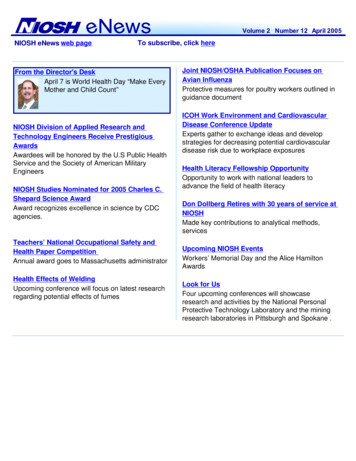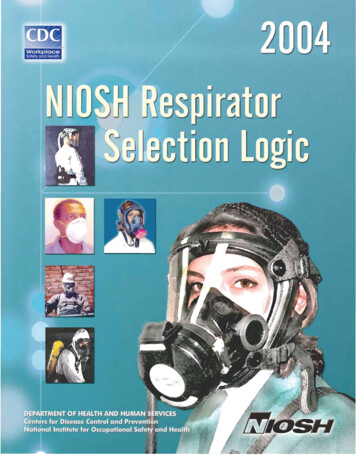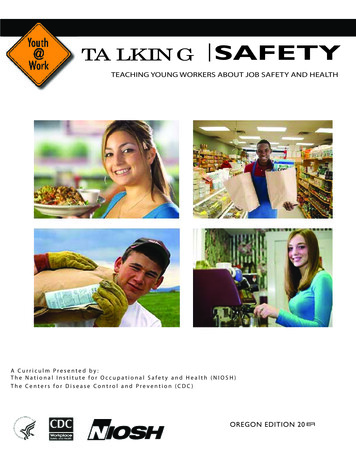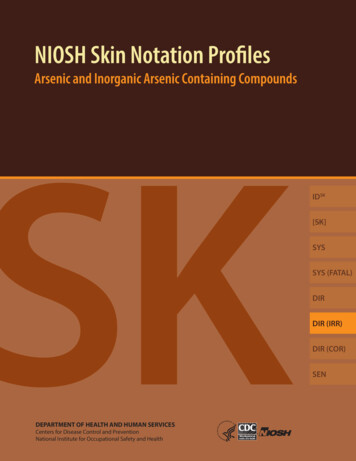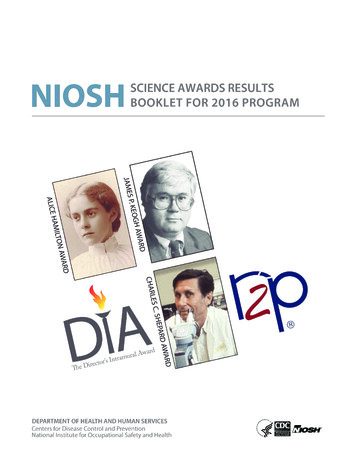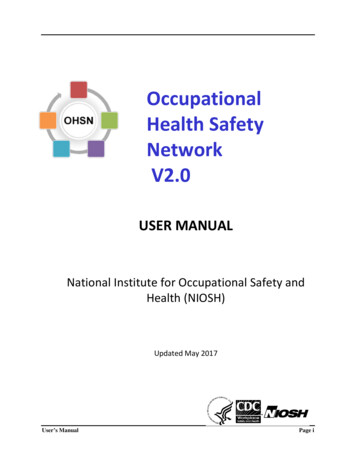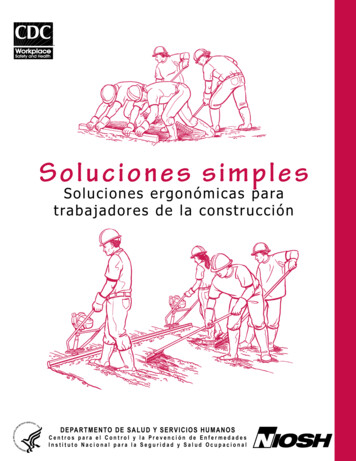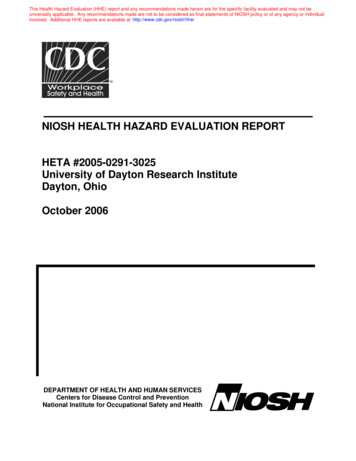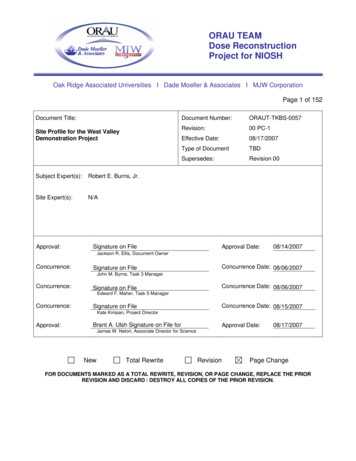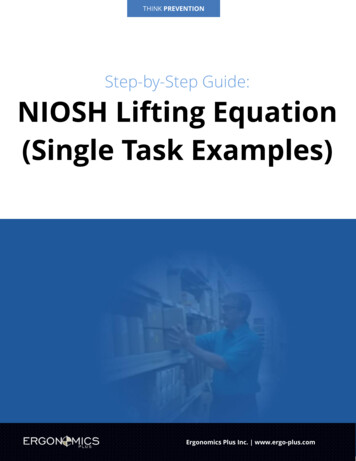
Transcription
THINK PREVENTIONStep-by-Step Guide:NIOSH Lifting Equation(Single Task Examples)Ergonomics Plus Inc. www.ergo-plus.com
NIOSH Lifting Equation: Single Task ExamplesThe following examples from the NIOSH Lifting Equation Applications Manual have beenadapted to show the proper use of the equation with our data collection worksheet andcalculator. In addition, the examples show how this tool can be used to evaluate bodymechanics recommendations and ergonomic redesign suggestions.How to Use the Example ProblemsThere are several approaches for controlling the stressors related to manual lifting. Oneapproach is to eliminate the manual requirements of the job by using hoists, cranes,manipulators, chutes, conveyors, or lift trucks, or through mechanization or automation. If themanual requirements of the job cannot be eliminated, then the demands of the job should bereduced through ergonomic design/redesign (e.g., modify the physical layout of the job orreduce the frequency or duration of lifting). As a last resort, and if redesign is not feasible, thestress on the worker should be reduced by distributing the stress between two or more workers(e.g., team lifting).In many cases elimination of manual lifting is not feasible or practical. Thus, ergonomicdesign/redesign is the best available control strategy. The goal of such a strategy is to reducethe demands of the job by reducing exposure to dangerous loading conditions and stressfulbody movements.Ergonomic design/redesign includes: (1) physical changes in the layout of the job, (2) reductionsin the lifting frequency rate and/or the duration of the work period, and (3) modifications of thephysical properties of the object lifted, such as type, size, or weight and/or improvement ofhand-to-object coupling.The lifting equation and procedures presented in this document were designed to identifyergonomic problems, and evaluate ergonomic design/redesign solutions. By examining thevalue of each task multiplier, the penalties associated with each job-related risk factor can beevaluated, thereby determining their relative importance in consideration of alternateworkplace designs. The task factors that cause the greatest reduction in the load constantshould be considered as the first priority for job redesign. Some general design/redesignsuggestions outlined in the applications manual are as follows: If HM 1.0 - Bring the load closer to the worker by removing any horizontal barriers orreducing the size of the object. Lifts near the floor should be avoided; if unavoidable,the object should fit easily between the legs.www.ergo-plus.comPAGE 2
NIOSH Lifting Equation: Single Task Examples If VM 1.0 - Raise/lower the origin/destination of the lift. Avoid lifting near the floor orabove the shoulders. If DM 1.0 - Reduce the vertical distance between the origin and the destination of thelift. If AM 1.0 - Move the origin and destination of the lift closer together to reduce theangle of twist, or move the origin and destination further apart to force the worker toturn the feet and step, rather than twist the body. If FM 1.0 - Reduce the lifting frequency rate, reduce the lifting duration, or providelonger recovery periods (i.e., light work period). If CM 1.0 - Improve the hand-to-object coupling by providing optimal containers withhandles or handhold cutouts, or improve the handholds for irregular objects. If RWL at the destination is less than at the origin - Eliminate the need for significantcontrol of the object at the destination by redesigning the job or modifying thecontainer/object characteristics.Examples are provided to demonstrate the proper application of the lifting equation andprocedures. The procedures provide a method for determining the level of physical stressassociated with a specific set of lifting conditions, and assist in identifying the contribution ofeach job-related factor. The examples also provide guidance in developing an ergonomicredesign strategy. Specifically, for each example, a job description, job analysis, hazardassessment, redesign suggestion, illustration, and completed worksheet are provided. The tenexamples were chosen to provide a representative sample of lifting jobs for which theapplication of this equation was suitable.The examples are organized as follows:Single Task, Performed a Few Times Per Shift1. Loading Punch Press Stock2. Loading Supply Rolls3. Loading Bags Into A HopperSingle Task, Performed Repetitively4. Package Inspection5. Dish-Washing Machine Unloading6. Product Packaging Iwww.ergo-plus.comPAGE 3
NIOSH Lifting Equation: Single Task ExamplesExample 1: Loading Punch Press StockJob Description:A punch press operator routinely handles small parts, feeding them into a press and removingthem. A cursory view of this task may overlook the fact that once per shift the operator mustload a heavy reel of supply stock (illustrated at floor height) from the floor onto the machine.The diameter of the reel is 30 inches, the width of the reel between the worker's hands is 12inches, and the reel weighs 44 lbs. Significant control of the load is required at the destinationof the lift due to the design of the machine. Also, the worker cannot get closer to the roll (i.e.,between the legs) because the roll is too awkward.Job Analysis:The task variable data are measured and recorded on the Ergonomics Plus data collectionworksheet as follows:www.ergo-plus.comPAGE 4
NIOSH Lifting Equation: Single Task ExamplesData collection worksheet:Assuming the operator lifts the reel in the plane shown, rather than on the side of the machine,the vertical height (V) at the origin is 15 inches, the vertical height (V) at the destination is 63inches, and the horizontal distance (H) is 23 inches at both the origin and the destination of thelift. The activity occurs only once per shift, so F is assumed to be 0.2 and duration is assumedto be less than 1 hour. No asymmetric lifting is involved (i.e., A 0), and the couplings areclassified as fair because the object is irregular and the fingers can be flexed about 90 degrees.Since significant control is required at the destination, the RWL must be computed at both theorigin and the destination of the lift.www.ergo-plus.comPAGE 5
NIOSH Lifting Equation: Single Task ExamplesHazard Assessment:Analyst:Mark MiddlesworthInputs:Task:Loading Supply Stock - OriginMultipliers:Horizontal Location(min. 10", max. 25")Vertical Location(min. 0", max. 70")Travel Distance(min 10", max. 70")Angle of Asymmetry(min. 0, max. 135)Coupling(1 good 2 fair 3 poor)Frequency(min. 0.2 .2FM1.00Avg. Load (lbs.)44Max Load (lbs.)44Duration (hours)1(enter 1, 2 or 8)ResultsRecommended Weight Limit (in pounds):RWL 16.03www.ergo-plus.comLifting Index:LI 2.74PAGE 6
FIRWL 16.03NIOSH Lifting Equation: Single Task Examples2.74FILI Recommendations:Engineering or ergonomic intervention should be implemented.Analyst:Mark MiddlesworthInputs:Horizontal Location(min. 10", max. 25")Vertical Location(min. 0", max. 70")Travel Distance(min 10", max. 70")Angle of Asymmetry(min. 0, max. 135)Coupling(1 good 2 fair 3 poor)Frequency(min. 0.2 lifts/min.)Loading Supply Stock - 1.002CM1.000.2FM1.00Avg. Load (lbs.)44Max Load (lbs.)44Duration (hours)1www.ergo-plus.comTask:PAGE 7
NIOSH Lifting Equation: Single Task Examples(enter 1, 2 or 8)ResultsRecommended Weight Limit (in pounds):Lifting Index:RWL 14.31LI 3.08FIRWL 14.31FILI 3.08Recommendations:Engineering or ergonomic intervention should be implemented.The RWL for this activity is 16.0 lb. at the origin and 14.3 lb. at the destination. The weight to belifted (44 lb.) is greater than the RWL at both the origin and the destination of the lift. The LI atthe origin is 2.74 and the LI at the destination is 3.08. These values indicate that this lift wouldbe hazardous for a majority of healthy industrial workers.Redesign Suggestions:The calculator above indicates that the smallest multipliers (i.e., the greatest penalties) are .43for the HM, .75 for the VM at the destination, and .86 for the DM. Therefore, the following jobmodifications are suggested:1. Bring the object closer to the worker at the destination to increase the HM value.2. Lower the destination of the lift to increase the VM value.3. Reduce the vertical travel distance between the origin and the destination of the lift toincrease the DM value.4. Modify the job so that significant control of the object at the destination is not required.This will eliminate the need to use the lower RWL value at the destination.If the operator could load the machine from the side, rather than the from the front, the reelcould be turned 90 degrees which would reduce the horizontal location of the hands at theorigin (i.e., H 10 inches) and destination of the lift (i.e., H 12 inches). The grip, however,www.ergo-plus.comPAGE 8
NIOSH Lifting Equation: Single Task Exampleswould be poor because the object is bulky and hard to handle and the fingers could not beflexed near 90 degrees when picking up the reel.Modified assessment using the improved body mechanics as suggested above:Analyst:Mark MiddlesworthInputs:Horizontal Location(min. 10", max. 25")Vertical Location(min. 0", max. 70")Travel Distance(min 10", max. 70")Angle of Asymmetry(min. 0, max. 135)Coupling(1 good 2 fair 3 poor)Frequency(min. 0.2 .2FM1.0044Max Load (lbs.)44(enter 1, 2 or 8)Loading Supply Stock – Modified OriginMultipliers:Avg. Load (lbs.)Duration (hours)Task:1Resultswww.ergo-plus.comPAGE 9
Recommended Weight Limit (in pounds):NIOSH Lifting Equation: Single Task ExamplesLifting Index:RWL 34.93LI 1.26FIRWL 34.93FILI 1.26Recommendations:Engineering or ergonomic intervention should be implemented.Analyst:Mark MiddlesworthInputs:Horizontal Location(min. 10", max. 25")Vertical Location(min. 0", max. 70")Travel Distance(min 10", max. 70")Angle of Asymmetry(min. 0, max. 135)Coupling(1 good 2 fair 3 poor)Frequency(min. 0.2 lifts/min.)www.ergo-plus.comTask:Loading Supply Stock – M0.860AM1.003CM0.900.2FM1.00PAGE 10
Avg. Load (lbs.)44Max Load (lbs.)44Duration (hours)NIOSH Lifting Equation: Single Task Examples1(enter 1, 2 or 8)ResultsRecommended Weight Limit (in pounds):Lifting Index:RWL 24.68LI 1.78FIRWL 24.68FILI 1.78Recommendations:Engineering or ergonomic intervention should be implemented.The RWL and corresponding LI values for this preferred combination of task variables (i.e.,loading the machine from the side) are shown on the modified job analysis sheets above. At theorigin, the RWL is 34.9 lb. and the LI is 1.26. At the destination, the RWL is 24.7 lb. and the LI is1.78. Since the LI is still greater than 1.0, however, a more comprehensive solution may beneeded. This could include: (1) lowering the vertical height of the destination, which wouldincrease the VM and the DM at both the origin and the destination of the lift; (2) reducing thesize and/or weight of the supply reel; (3) transferring the supply reel from the storage area on amobile, mechanical lifting device or jack that could be moved near the machine to eliminate theneed for manual lifting. If it is not feasible to eliminate or redesign the job, then othermeasures, such as assigning two or more workers, could be considered as an interim controlprocedure.Comments:www.ergo-plus.comPAGE 11
NIOSH Lifting Equation: Single Task ExamplesAlthough ergonomic redesign is preferred, this example demonstrates how a change in workpractices (i.e., insuring that the operator can load the reel from the side) can reduce themagnitude of physical stress associated with a manual lifting task. This approach, however,relies more on worker compliance than on physical job modifications.www.ergo-plus.comPAGE 12
NIOSH Lifting Equation: Single Task ExamplesExample 2: Loading Supply RollsJob Description:With both hands directly in front of the body, a worker lifts the core of a 35-lb roll of paperfrom a cart, and then shifts the roll in the hands and holds it by the sides to position it on amachine, as shown below. Significant control of the roll is required at the destination of the lift.Also, the worker must crouch at the destination of the lift to support the roll in front of thebody, but does not have to twist.Job Analysis:The task variable data are measured and recorded on the Ergonomics Plus data collectionworksheet as follows:www.ergo-plus.comPAGE 13
NIOSH Lifting Equation: Single Task ExamplesData collection worksheet:The vertical location of the hands is 27 inches at the origin and 10 inches at the destination. Thehorizontal location of the hands is 15 inches at the origin and 20 inches at the destination. Theasymmetric angle is 0 degrees at both the origin and the destination, and the frequency is 4lifts/shift (i.e., less than .2 lifts/min for less than 1 hour). The coupling is classified as poorbecause the worker must reposition the hands at the destination of the lift and they can’t flexthe fingers to the desired 90 degrees angle (e.g., hook grip). No asymmetric lifting is involved(i.e., A 0), and significant control of the object is required at the destination of the lift. Thus,the RWL should be computed at both the origin and the destination of the lift.www.ergo-plus.comPAGE 14
NIOSH Lifting Equation: Single Task ExamplesHazard Assessment:Analyst:Mark MiddlesworthInputs:Task:Loading Paper Supply Rolls - OriginMultipliers:Horizontal Location(min. 10", max. 25")Vertical Location(min. 0", max. 70")Travel Distance(min 10", max. 70")Angle of Asymmetry(min. 0, max. 135)Coupling(1 good 2 fair 3 poor)Frequency(min. 0.2 .2FM1.00Avg. Load (lbs.)35Max Load (lbs.)35Duration (hours)1(enter 1, 2 or 8)ResultsRecommended Weight Limit (in pounds):RWL 27.69www.ergo-plus.comLifting Index:LI 1.26PAGE 15
FIRWL 27.69NIOSH Lifting Equation: Single Task Examples1.26FILI Recommendations:Engineering or ergonomic intervention should be implemented.Analyst:Mark MiddlesworthInputs:Horizontal Location(min. 10", max. 25")Vertical Location(min. 0", max. 70")Travel Distance(min 10", max. 70")Angle of Asymmetry(min. 0, max. 135)Coupling(1 good 2 fair 3 poor)Frequency(min. 0.2 lifts/min.)Loading Paper Supply Rolls 1.003CM0.900.2FM1.00Avg. Load (lbs.)35Max Load (lbs.)35www.ergo-plus.comTask:PAGE 16
Duration (hours)NIOSH Lifting Equation: Single Task Examples1(enter 1, 2 or 8)ResultsRecommended Weight Limit (in pounds):Lifting Index:RWL 18.06LI 1.94FIRWL 18.06FILI 1.94Recommendations:Engineering or ergonomic intervention should be implemented.The weight to be lifted (35 lb.) is greater than the RWL at both the origin and destination of thelift (27.7 lb. and 18.1 lb. respectively). The LI at the origin is 1.26, and the LI at the destination is1.94. These values indicate that this job is only slightly stressful at the origin, but moderatelystressful at the destination of the lift.Redesign Suggestions:The first choice for reducing the risk of injury for workers performing this task would be toadapt the cart so that the paper rolls could be easily pushed into position on the machine,without manually lifting them.If the cart cannot be modified, then the results of the equation may be used to suggest taskmodifications. The calculator worksheet above indicates that the multipliers with the smallestmagnitude (i.e., those providing the greatest penalties) are .50 for the HM at the destination,.67 for the HM at the origin, .85 for the VM at the destination, and .90 for the CM value. Thefollowing job modifications are suggested:1. Bring the load closer to the worker by making the roll smaller so that the roll can belifted from between the worker's legs. This will decrease the H value, which in turn willincrease the HM value.2. Raise the height of the destination to increase the VM.3. Improve the coupling to increase the CM.www.ergo-plus.comPAGE 17
NIOSH Lifting Equation: Single Task ExamplesIf the size of the roll can’t be reduced, then the vertical height (V) of the destination should beincreased. Using the calculator modified assessment as shown below, you can see whathappens to the RWL and LI for this lifting task if V is increased to 30 inches at the destination:Analyst:Mark MiddlesworthInputs:Horizontal Location(min. 10", max. 25")Vertical Location(min. 0", max. 70")Travel Distance(min 10", max. 70")Angle of Asymmetry(min. 0, max. 135)Coupling(1 good 2 fair 3 poor)Frequency(min. 0.2 2FM1.0035Max Load (lbs.)35(enter 1, 2 or 8)Loading Paper Supply Rolls DestinationMultipliers:Avg. Load (lbs.)Duration (hours)Task:1Resultswww.ergo-plus.comPAGE 18
Recommended Weight Limit (in pounds):NIOSH Lifting Equation: Single Task ExamplesLifting Index:RWL 30.60LI 1.14FIRWL 30.60FILI 1.14Recommendations:Engineering or ergonomic intervention should be implemented.The VM would be increased from .85 to 1.0; the H value would be decreased from 20 inches to15 inches, which would increase HM from .50 to .67.; and the DM would be increased from .93to 1.0. Thus, the final RWL would be increased from 18.1 lb. to 30.6 lb., and the LI at thedestination would decrease from 1.94 to 1.14. In some cases, redesign may not be feasible. Inthese cases, use of a mechanical lift may be more suitable. As an interim control strategy, twoor more workers may be assigned to lift the supply roll.Comments:The horizontal distance (H) is a significant factor that may be difficult to reduce because the sizeof the paper rolls may be fixed. Moreover, redesign of the machine may not be practical.Therefore, elimination of the manual lifting component of the job may be more appropriatethan job redesign.www.ergo-plus.comPAGE 19
NIOSH Lifting Equation: Single Task ExamplesExample 3: Loading Bags into a HopperJob Description:The worker positions himself midway between the hand truck and the mixing hopper, asillustrated in the picture below. Without moving his feet, he twists to the right and picks up abag off the hand truck. In one continuous motion he then twists to his left to place the bag onthe rim of the hopper. A sharp edged blade within the hopper cuts open the bag to allow thecontents to fall into the hopper. This task is done infrequently (i.e., 1-12 times per shift) withlarge recovery periods between lifts (i.e., 1.2 Recovery Time/Work Time ratio). In observingthe worker perform the job, it was determined that the non-lifting activities could bedisregarded because they require minimal force and energy expenditure. Significant control isnot required at the destination, but the worker twists at the origin and destination of the lift.Although several bags are stacked on the hand truck, the highest risk of overexertion injury isassociated with the bag on the bottom of the stack; therefore, only the lifting of the bottombag will be examined. Note, however, that the frequency multiplier is based on the overallfrequency of lifting for all of the bags.Job Analysis:The task variable data are measured and recorded on the Ergonomics Plus data collectionworksheet as follows:www.ergo-plus.comPAGE 20
NIOSH Lifting Equation: Single Task ExamplesData collection worksheet:The vertical location of the hands is 15 inches at the origin and 36 inches at the destination. Thehorizontal location of the hands is 18 inches at the origin and 10 inches at the destination. Theasymmetric angle is 45 degrees at the origin and 45 degrees at the destination of the lift, andthe frequency is less than .2 lifts/min for less than 1 hour. The coupling is classified as fairbecause the worker flexes the fingers about 90 degrees and the bags are semi-rigid (i.e., theydo not sag in the middle).www.ergo-plus.comPAGE 21
NIOSH Lifting Equation: Single Task ExamplesHazard Assessment:Analyst:Mark MiddlesworthInputs:Task:Dumping bags into hopper - OriginMultipliers:Horizontal Location(min. 10", max. 25")Vertical Location(min. 0", max. 70")Travel Distance(min 10", max. 70")Angle of Asymmetry(min. 0, max. 135)Coupling(1 good 2 fair 3 poor)Frequency(min. 0.2 0.2FM1.00Avg. Load (lbs.)40Max Load (lbs.)40Duration (hours)1(enter 1, 2 or 8)ResultsRecommended Weight Limit (in pounds):RWL 18.52www.ergo-plus.comLifting Index:LI 2.16PAGE 22
FIRWL 18.52NIOSH Lifting Equation: Single Task Examples2.16FILI Recommendations:Engineering or ergonomic intervention should be implemented.Significant control of the object is not required at the destination of the lift so the RWL iscomputed only at the origin. The RWL for this activity is 18.5 lb. The weight to be lifted (40 lb.)is greater than the RWL (18.5 lb.). Therefore, the LI is 40/18.5 or 2.16. This job would bephysically stressful for many industrial workers.Redesign Suggestions:The smallest multipliers (i.e., the greatest penalties) are .56 for the HM, .86 for the AM, and .89for the VM. The following job modifications are suggested:1. Bringing the load closer to the worker to increase the HM.2. Reducing the angle of asymmetry to increase AM. This could be accomplished either bymoving the origin and destination points closer together or further apart.3. Raising the height at the origin to increase the VM.Analyst:Mark MiddlesworthInputs:Horizontal Location(min. 10", max. 25")Vertical Location(min. 0", max. 70")Travel Distance(min 10", max. 70")Angle of Asymmetrywww.ergo-plus.comTask:Dumping bags into hopper - 45AM0.86PAGE 23
NIOSH Lifting Equation: Single Task Examples(min. 0, max. 135)Coupling(1 good 2 fair 3 poor)Frequency(min. 0.2 lifts/min.)2CM0.950.2FM1.00Avg. Load (lbs.)40Max Load (lbs.)40Duration (hours)1(enter 1, 2 or 8)ResultsRecommended Weight Limit (in pounds):Lifting Index:RWL 33.34LI 1.20FIRWL 33.34FILI 1.20Recommendations:Engineering or ergonomic intervention should be implemented.As shown in the modified worksheet above, if the worker could get closer to the bag beforelifting, the H value could be decreased to 10 inches, which would increase the HM to 1.0, theRWL would be increased to 33.3 lb., and the LI would be decreased to 1.20.Comments:www.ergo-plus.comPAGE 24
NIOSH Lifting Equation: Single Task ExamplesThis example demonstrates that certain lifting jobs may be evaluated as a single-task or multitask job. In this case, only the most stressful component of the job was evaluated. For repetitivelifting jobs, the multi-task approach may be more appropriate.www.ergo-plus.comPAGE 25
NIOSH Lifting Equation: Single Task ExamplesExample 4: Package InspectionJob Description:This job consists of a worker inspecting compact containers for damage on a low shelf, and thenlifting them with both hands directly in front of the body from shelf 1 to shelf 2 at a rate of 3per minute for a duration of 45 minutes. For this analysis, assume that (1) the worker cannottake a step forward when placing the object at the destination, due to the bottom shelf, and (2)significant control of the object is required at the destination. The containers are of optimaldesign, but without handles.Job Analysis:The task variable data are measured and recorded on the Ergonomics Plus data collectionworksheet as follows:www.ergo-plus.comPAGE 26
NIOSH Lifting Equation: Single Task ExamplesData collection worksheet:The horizontal distance at the origin of the lift is 10 inches and the horizontal distance at thedestination of the lift is 20 inches. The height of shelf one is 22 inches and the height of shelftwo is 59 inches. Since the container is of optimal design, but does not have handles orhandhold cutouts, the coupling is defined as "fair” (i.e., C 2). No asymmetric lifting is involved(i.e., A 0). Since the lifting pattern is continuous over the 45 minute work session, the liftingfrequency is not adjusted. Significant control of the load is required at the destination of thelift. Therefore, the RWL is computed at both the origin and the destination of the lift.www.ergo-plus.comPAGE 27
NIOSH Lifting Equation: Single Task ExamplesHazard Assessment:Analyst:Mark MiddlesworthInputs:Task:Packing inspection - OriginMultipliers:Horizontal Location(min. 10", max. 25")Vertical Location(min. 0", max. 70")Travel Distance(min 10", max. 70")Angle of Asymmetry(min. 0, max. 135)Coupling(1 good 2 fair 3 poor)Frequency(min. 0.2 FM0.88Avg. Load (lbs.)26Max Load (lbs.)26Duration (hours)1(enter 1, 2 or 8)ResultsRecommended Weight Limit (in pounds):RWL 34.81www.ergo-plus.comLifting Index:LI 0.75PAGE 28
FIRWL 39.56NIOSH Lifting Equation: Single Task ExamplesFILI 0.66Recommendations:Nominal risk.Analyst:Mark MiddlesworthInputs:Horizontal Location(min. 10", max. 25")Vertical Location(min. 0", max. 70")Travel Distance(min 10", max. 70")Angle of Asymmetry(min. 0, max. 135)Coupling(1 good 2 fair 3 poor)Frequency(min. 0.2 lifts/min.)Packing inspection - 1.002CM1.003FM0.88Avg. Load (lbs.)26Max Load (lbs.)26Duration (hours)1www.ergo-plus.comTask:PAGE 29
NIOSH Lifting Equation: Single Task Examples(enter 1, 2 or 8)ResultsRecommended Weight Limit (in pounds):Lifting Index:RWL 15.25LI 1.70FIRWL 17.33FILI 1.50Recommendations:Engineering or ergonomic intervention should be implemented.The RWL for this activity is 34.8 lb. at the origin and 15.3 lb. at the destination. The weight to belifted (26 lb.) is less than the RWL at the origin (34.9 lb.) but greater than the RWL at thedestination (15.2 lb.). The LI is 26/34.8 is .75 at the origin, and the LI is 26/15.3 or 1.70 at thedestination. These values indicate that the destination of the lift is more stressful than theorigin, and that some healthy workers would find this task physically stressful.Redesign Suggestions:The multipliers with the smallest magnitude (i.e., those that provide the greatest penalties) are.50 for the HM at the destination, .78 for the VM, .87 for the DM, and .88 for the FM at thedestination of the lift. The following job modifications are suggested:1. Bring the destination point closer to the worker to increase the HM value.2. Lower the height of shelf 2 to increase the VM value.3. Decrease the vertical distance between origin and destination of lift to increase the DMvalue.4. Reduce the lifting frequency rate to increase the FM value.5. Modify the task so that there is no need for significant control of the object at thedestination to eliminate the lower RWL value.www.ergo-plus.comPAGE 30
Analyst:Mark MiddlesworthInputs:NIOSH Lifting Equation: Single Task ExamplesTask:Packing inspection - ModifiedDestinationMultipliers:Horizontal Location(min. 10", max. 25")Vertical Location(min. 0", max. 70")Travel Distance(min 10", max. 70")Angle of Asymmetry(min. 0, max. 135)Coupling(1 good 2 fair 3 poor)Frequency(min. 0.2 FM0.88Avg. Load (lbs.)26Max Load (lbs.)26Duration (hours)1(enter 1, 2 or 8)ResultsRecommended Weight Limit (in pounds):RWL 27.68www.ergo-plus.comLifting Index:LI 0.94PAGE 31
FIRWL 31.45NIOSH Lifting Equation: Single Task ExamplesFILI 0.83Recommendations:Nominal risk.Practical job modifications could include bringing shelf 2 closer to the worker to reduce H,raising the height of shelf 1 to increase the CM value, lowering the height of shelf 2 to reduce D,or reducing the need for significant control at the end of the lift by providing a receiving chute.Comments:As the modified worksheet above shows, if the H is reduced to 14” and the destination V islowered to 39”, the RWL would now be 27.7 lb. and the LI would be .94. This ergonomic designimprovement would significantly lower the injury risk to healthy employees.Example 5: Dish-Washing MachineUnloadingJob Description:A worker manually lifts trays of clean dishes from a conveyor at the end of a dish washingmachine and loads them on a cart as shown below. The trays are filled with assorted dishes(e.g., glasses, plates, bowls) and silverware. The job takes between 45 minutes and 1 hour tocomplete, and the lifting frequency rate averages 5 lifts/min. Workers usually twist to one sideof their body to lift the trays (i.e., asymmetric lift) and then rotate to the other side of theirbody to lower the trays to the cart in one smooth continuous motion. The maximum amount ofasymmetric twist varies between workers and within workers, however, there is usually equaltwist to either side. During the lift the worker may take a step toward the cart. The trays havewell designed handhold cutouts and are made of lightweight materials.www.ergo-plus.comPAGE 32
NIOSH Lifting Equation: Single Task ExamplesJob Analysis:The task variable data are measured and recorded on the Ergonomics Plus data collectionworksheet as follows:Data collection worksheet:At the origin of the lift, the horizontal distance (H) is 20 inches, the vertical distance (V) is 44inches, and the angle of asymmetry (A) is 30 degrees. At the destination of the lift, H is 20inches, V is 7 inches, and A is 30 degrees. The trays normally weigh from 5 lb. to 20 lb., but forthis example, assume that all of the trays weigh 20 lb. The coupling is classified as “good”.www.ergo-plus.comPAGE 33
NIOSH Lifting Equation: Single Task ExamplesSignificant control of the load is required at the destination of the lift. Therefore, the RWL iscomputed at both the origin and the destination of the lift.www.ergo-plus.comPAGE 34
NIOSH Lifting Equation: Single Task ExamplesHazard Assessment:Analyst:Mark MiddlesworthInputs:Horizontal Location(min. 10", max. 25")Vertical Location(min. 0", max. 70")Travel Dist
www.ergo-plus.com PAGE 3 NIOSH Lifting Equation: Single Task Examples If VM 1.0 - Raise/lower the origin/destination of the lift. Avoid lifting near the floor or above the shoulders. If DM 1.0 - Reduce the vertical distance between the origin and the destination of the lift.
